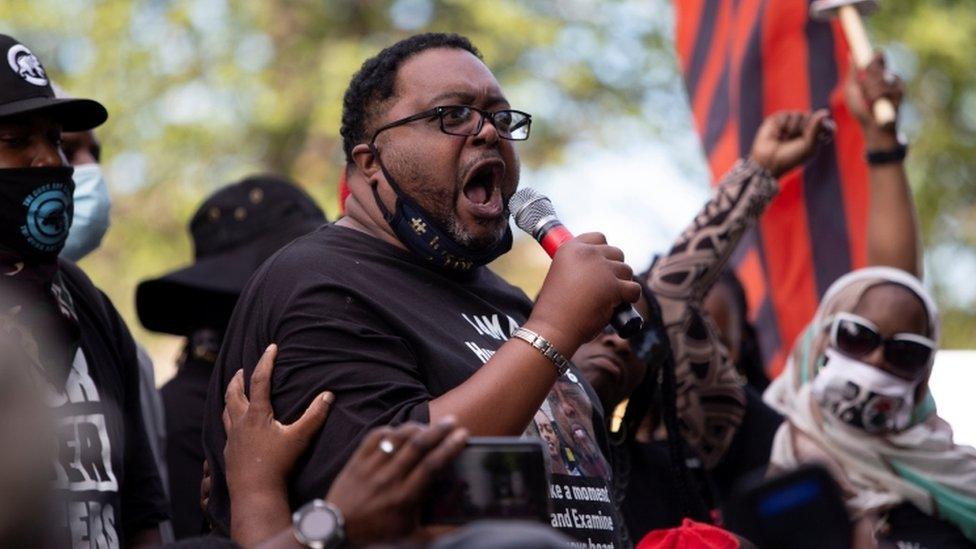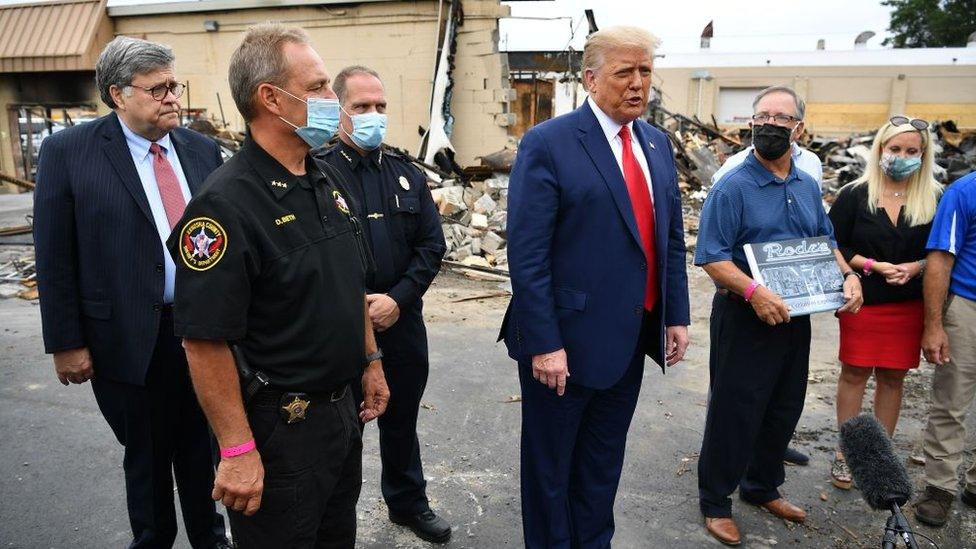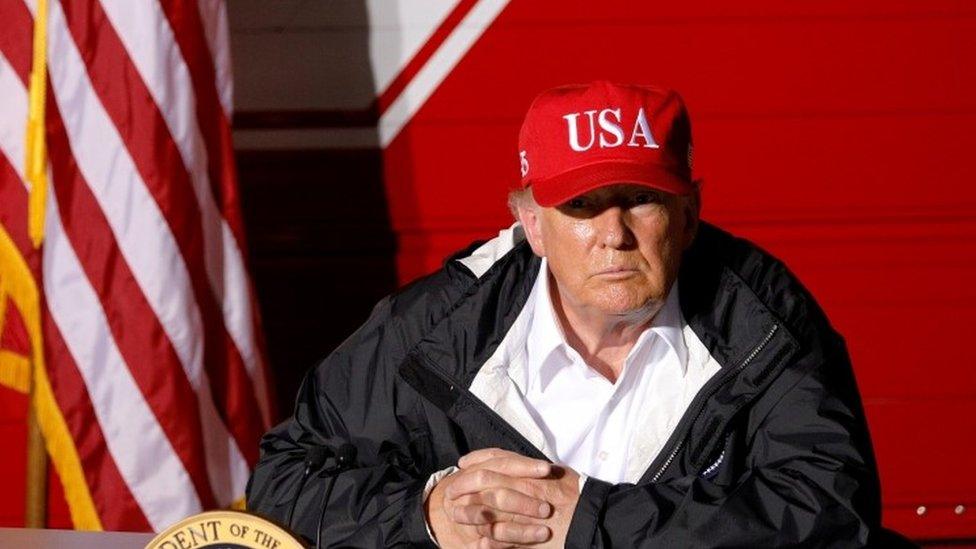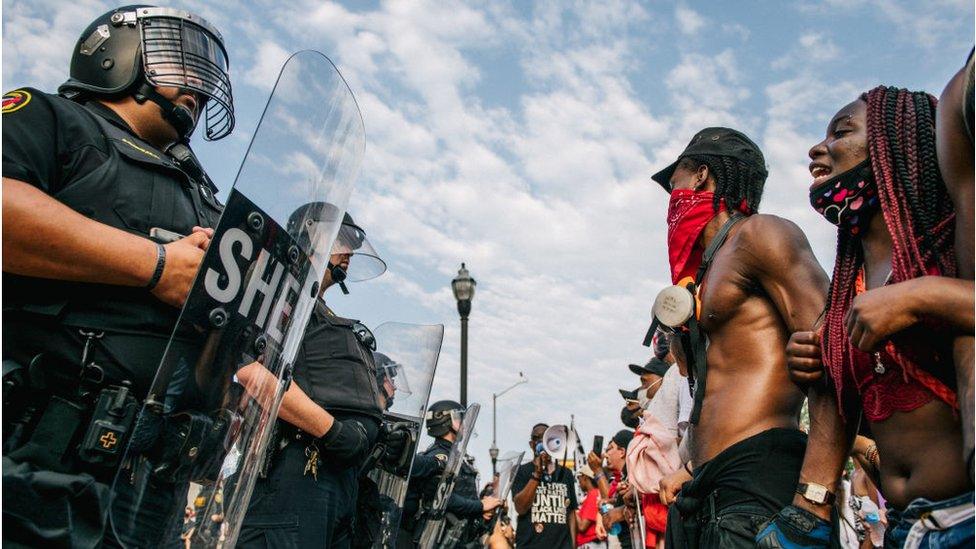Jacob Blake: Trump visits Kenosha to back police after shooting
- Published
Trump on police: 'They choke sometimes'
US President Donald Trump has visited Kenosha, Wisconsin, to back law enforcement after the police shooting of a black man sparked civil strife.
The Republican president blamed "domestic terror" for the "destruction" in the Midwestern city.
Kenosha saw days of violence after police shot Jacob Blake in the back and left him paralysed on 23 August.
Mr Trump has been lagging behind Joe Biden in opinion polls, although some polls have tightened in recent weeks.
The president is pushing a campaign message of "law and order" - however, Mr Biden has accused Mr Trump of stoking racial division.
"Fires are burning and we have a president who fans the flames rather than fighting the flames," the former US vice-president said ahead of Mr Trump's trip on Tuesday.
A police officer shot Jacob Blake seven times in the back during an arrest as the 29-year-old tried to get into a car where his three children were seated.
What did Trump say in Kenosha?
The president visited areas damaged in the protests, including a burnt-out furniture store and camera shop destroyed in the upheaval.
"These are not acts of peaceful protest, but really domestic terror," he later told local business leaders at a round table meeting in a high school gym.
Mr Trump defended the actions of US police and accused the media of focusing only on "bad" incidents involving officers.
"You have people that choke," he said. "They are under tremendous pressure. And they may be there for 15 years and have a spotless record and all of a sudden they're faced with a decision. They have a quarter of a second to make a decision. And if they make a wrong decision, one way or the other, they're either dead or they're in big trouble.
"And people have to understand that. They choke sometimes."
The president also expressed sympathy for those hurt in confrontations with police, saying he felt "terribly for anybody who goes through that". But he said he did not believe there was systemic racism in law enforcement.
As part of his "law and order" messaging, Mr Trump said he sent the National Guard into Kenosha. However, in reality they were deployed by Wisconsin's governor and supported by 200 federal law enforcement officials ordered in by the president.
Mr Trump also said his administration would provide nearly $4m (£3m) to help Kenosha businesses that had been damaged in the riots and $1m for city law enforcement.
Demonstrators have accused outside agitators of violently hijacking their protests. Kenosha police said at the weekend that 105 out of 175 suspects arrested during the unrest came from outside the city.

Jacob Blake's father said his son was "holding on for dear life"
Why didn't Trump meet the Blake family?
The president said he did not meet Jacob Blake's family because they had wanted lawyers present.
Mr Trump instead said he was honoured to have the African-American co-pastors of Mr Blake's mother at the roundtable.
Co-pastor Sharon Ward said: "I think it's important to have black people at the table to help solve the problem."
Earlier in an interview with CNN, external, Mr Blake's father, Jacob Blake Snr, said his son's life was more important than a meeting with President Trump.
Jacob Blake's sister: 'I have been watching police murder people that look like me for years'
"I'm not getting into politics. It's all about my son, man. It has nothing to do with a photo op," he said.
Mr Blake Snr said his son was still paralysed from the waist down, "holding on for dear life".
Was there criticism of the visit?
Mr Trump's visit to Kenosha went ahead despite appeals from the Democratic mayor and governor to stay away.
Over the weekend Kenosha Mayor John Antaramian said it was not a good time for Mr Trump to visit.
"Realistically, from our perspective, our preference would have been for him not to be coming at this point in time," he told National Public Radio.
Wisconsin's Democratic Governor Tony Evers also warned against the visit, saying it would "hinder our healing".

Mr Trump posed in front of a burned down camera shop with a man he wrongly claimed to be the business owner
Congressman Mark Pocan, a Wisconsin Democrat who grew up in Kenosha, said on Twitter the president visited the city "to spread hate".
Kenosha business owner Tom Gram, whose century-old camera shop was destroyed in the riots, said that he had refused a request from the White House to appear with Mr Trump when he toured the ruined buildings.
"I think everything he does turns into a circus and I just didn't want to be involved in it," Mr Gram told WTMJ-TV, external.
Mr Trump later appeared at the building with the property owner, who he wrongly told reporters was the business owner.
Mr Gram said the footage shocked him, and that he disagreed with the message Mr Trump was sending.
"I think he needs to bring this country together rather than divide it," he said, adding: "I think there's a lot of good people in this community and to say that only law enforcement is correct is not the message we need to hear right now."


President Trump flew straight into the latest hotspot in this incendiary summer of racial reckoning, even though the governor asked him not to come.
Democrats have accused the president of fanning the flames of unrest.
He has focused on the violence that's accompanied some protests rather than the grievances of the anti-racism demonstrators.
Mr Trump told us he thought his message was helping to bridge racial divides because black and Hispanic Americans were also against crime and he was about "law and order".
Almost certainly the president sees a political opportunity by visiting this Midwestern town in the crucial swing state of Wisconsin.
Kenosha has emerged as the new epicentre of the debate over race and violence and how each presidential candidate will handle this explosive issue.

- Published1 September 2020

- Published30 August 2020

- Published28 August 2020
